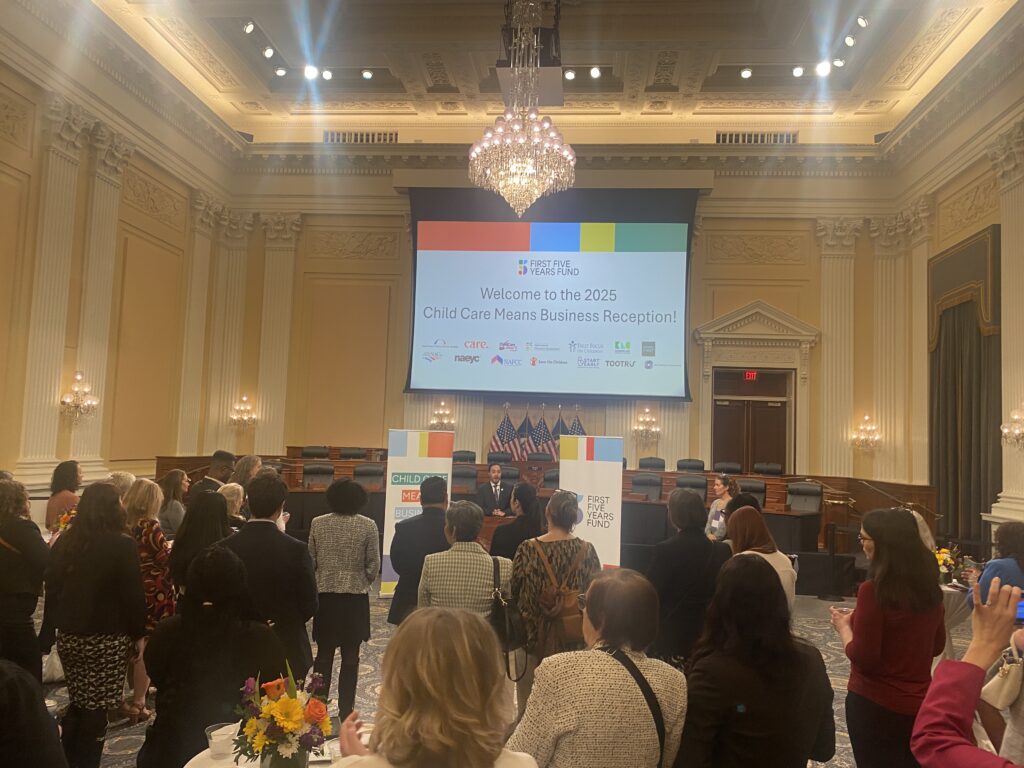President Biden Prioritizes Child Care & Pre-K for New Economic Policy Plan
Since taking office, President Biden has made child care “a cornerstone of his economic policy agenda” and the White House has doubled-down in recent weeks on passing an economic package with child care and pre-K included. It’s notable that, of the many important policies included in the original Build Back Better Act proposal, President Biden singled out child care and pre-K as one of the three pillars of his new plan to cut inflation and lower the deficit, which he unveiled during his State of the Union address.
As the president said last night: “Third – cut the cost of child care. Many families pay up to $14,000 a year for child care per child. Middle-class and working families shouldn’t have to pay more than 7% of their income for care of young children. My plan will cut the cost in half for most families and help parents, including millions of women, who left the workforce during the pandemic because they couldn’t afford child care, to be able to get back to work. My plan doesn’t stop there. It also includes home and long-term care. More affordable housing. And Pre-K for every 3- and 4-year-old. All of these will lower costs.”
Here’s what Congress is saying about the president’s plan:
- Senator Patty Murray, Chair of Senate HELP Committee: Ask any working parent and they’ll agree that child care is too expensive. I’m glad @POTUS is making lowering child care costs for families a priority—and I have a plan Congress could pass this week to get it done.
- Congresswoman Susan DelBene, Chair of House New Democrat Coalition: Working families shouldn’t have to pay more than 7% of their income for care of young children. For too many in WA, this is the reality of child care & it must change.
- Congresswoman Katherine Clark, Assistant Speaker of the House: You heard @POTUS: many families pay up +$14,000 a year for #childcare — per child! Families shouldn’t have to pay more than 7% of their income for child care. Our plan will cut the cost by HALF. That’s how we build a stronger America.
“The president’s message tonight was clear: Congress should prioritize child care and early learning and send a bill lowering families’ costs to his desk for signature,” said First Five Years Fund Executive Director Sarah Rittling. “President Biden understands that the high cost and limited supply of child care and pre-K has held working families back for too long. We have an opportunity to provide relief to parents and build an early learning system that meets the needs of families, providers, and our economy. So as we think about addressing today’s challenges and building a stronger economic future for this country, there’s no question that early care and education must be central to the conversation.”
As it stands, the steadily dwindling supply, high price, and unsustainability of child care as a market is a recipe for failure for a service that millions of families rely on just to be able to work each day.
Sky-High Prices, Insufficient Supply
- As of 2020, the average price of center-based child care for an infant in the United States is $12,300. For all children under age six, the average annual price of care is around $10,174, or roughly $200 per week. In some states, the average annual price of care for one child is over $20,000.
- Since 1990, average child care costs have risen 214%, far outpacing the increase in average family income and increases in other major household expenses like housing and groceries.
- In three out of four regions of the U.S., the annual price of center-based child care for an infant exceeds the cost of housing. In all four regions, the annual price of child care exceeds the annual cost of in‑state tuition at a public four‑year university.
- Four out of ten parents now say they have gone into debt to pay for child care, and 28% say they’ve had to choose between paying for child care or paying their rent or mortgage on time.
- One in three parents across the country with kids under five say they are having serious problems finding child care or preschool options for their children.
- Meanwhile, over half of Americans live in a child care desert, with more than 50 children under age five that contains either no child care providers or so few options that there are more than three times as many children as licensed child care slots.
A Failing Sector with Desperate Providers and Care Professionals
- Child care is a specialized, labor-intensive service to provide, and personnel costs represent the largest portion of programs’ budgets (roughly 65% on average). Because providers can only charge what parents can afford to pay, most struggle to provide adequate compensation and benefits to their employees.
- The average wage of child care professionals is $12.24 per hour. For those with a Bachelor’s Degree, it is $13.83 an hour.
- Two years into a pandemic that has seen roughly 16,000 child care programs permanently close, federal relief funding is offering a critical lifeline to providers and families, preventing the total collapse of the child care market.
- However, that funding expires next year and, according to a new survey, 75% of providers have said that the end of federal relief will have a negative or highly negative effect on their programs.
- Even high parent fees are not enough to cover the cost of providing care. Child care providers operate their programs on razor thin margins. Analysis from Child Care Aware of America estimates it costs $16,836 for a center in Delaware to provide care for one infant, while the price families pay for care is $11,761.
- More than 30% of child care providers are considering quitting or closing down their businesses within the next year, which could decrease an already waning supply of care.
- Despite America’s recent strong job growth, child care employment remains 12.4% below pre-pandemic levels. In comparison, overall employment is only 1.9% below pre-pandemic levels.
- A recent analysis shows one out of every three child care workers experienced food insecurity in 2020.
- There is no market-based solution to America’s child care crisis. Only with significant, sustained federal investment can providers afford to provide high-quality care at a price families can afford to pay.
The American Workforce Relies on Child Care
- Today, 26.8 million people — that’s 16% of the U.S. workforce — rely on child care in order to go to work.
- When parents can’t find or afford quality care, they’re unable to enter, reenter, or remain in the workforce.
- A December 2021 survey found the number three biggest reason for unemployment was the need to take care of families at home.
- A U.S. Chamber of Commerce Foundation report shows that states are losing out on billions of dollars in economic activity each year due to breakdowns in child care, disrupting parents’ ability to work.
- Businesses across America lose an estimated $12.7 billion annually because parents – due to a breakdown in the child care system – aren’t able to show up for work, or have to leave the workforce entirely.
- Parents across America lose about $30-35 billion in income as they reduce working hours or leave the workforce given unaffordable early care and education costs.
Subscribe to FFYF First Look
Every morning, FFYF reports on the latest child care & early learning news from across the country. Subscribe and take 5 minutes to know what's happening in early childhood education.



